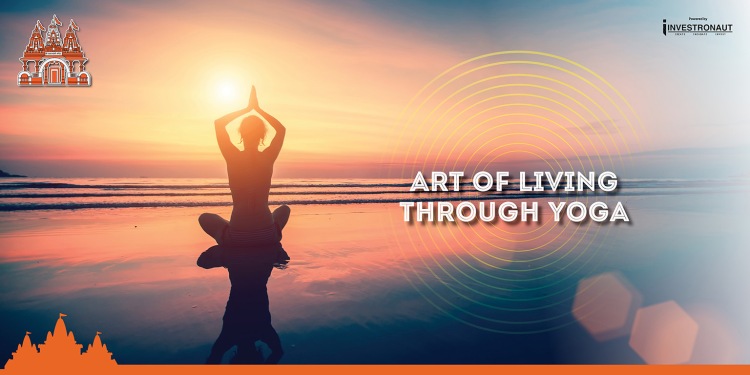
Ahead of World Yoga Day, which is on 21st June, lets try to understand the basic idea of Yoga. The more common practise that we know of yoga, has driven the whole world towards it, like some mystical form of the Holy Grail. Yet, Yoga is not limited to exercise alone. This 5,000 year old wellness pursuit is the art of living that ignites positivity in everyone.
Yoga is a beautiful forum to explore, practise and experience the universe through oneself. Ashtanga Yoga, has been misinterpreted as eight ‘limbs’ in yoga. However, Anga in Sanskrit it means sections or levels. Thus, ashtanga actually translates to eight levels of yoga. It demands a complete control of the mind, body and soul, once you start evolving through it. It includes mastering the control of your inner self, your body and creates a positive attitude through yourself. Many know Yoga as a self-healing process and it helps in curing different ailments of the body. It allows you to recognize your true potential and spiritually awakens your soul. Of course, this is all true. However, in order to achieve this exalted state, entirely, it should be practised in a systematic manner.
The Eight Stages of Ashtanga Yoga

YAMA: Yama means moral observance that helps one to attain harmony with the universe. Yama is a result of five liberal principles that when practised regularly, will direct you towards being in harmony with the universe. When one masters these principles, unknowingly, you attain the next level of Ashtanga Yoga.
NIYAMA: Niyama allows you to attain harmony with your body through another five principles of moral observance. In a way, it intends to purify the inner elements of the body. When we speak about the body, it does not mean the physical form but, the identity of an individual in the universe.
Yama and Niyama are two fundamental facets of Ashtanga Yoga that work in unison to emancipate oneself. Therefore, when you start practising Yama, in a way, you start practicing Niyama as well. The 10 principles of moral observance to be in harmony with universe and yourself are an initiation towards bringing a positive shift in your life.
Link for 10 Principles of Yama and Niyama:
ASANA: If you Google Ashtanga Yoga, the images thrown up, show people in impossible poses, flexing and toning their bodies. Asanas are, in fact, a mirror to learn about yourself. But, Asana is just a stage amongst the other eight stages that comprise Ashtanga Yoga. When you start practising Asanas, you learn unknown things about the body and about yourself as a whole.
Unfortunately, when one commences learning yoga, the first thing you learn are the limitations of your body that can deflate your ego. It forces one to have feelings of inadequacy and mental intolerance. However, it is at this time when you have to be consistent and self motivated. As you move through these three stages onto the next, you will have taken the first step towards better living. When you practise Asanas, you learn a lot about your body. You are more aware of your body and you gradually start focusing on your existence.
PRANA: Prana here means the awareness of pranic energy. It is the art of regulating your breath, learning how to use breath to your benefit. Breathing is something that we do naturally. However, we have never learnt a systematic form of breathing. When you learn how to regulate your breath, your body starts responding in a completely different manner. It washes out the impurities, accepts only what is best for the body and processes it accordingly.
PRATYAHARA: The ultimate control of the five senses of the body means Pratyahara. The fundamental objective of this stage in Ashtanga Yoga, is to stop abusing the body – physically, emotionally or mentally. Getting addicted to food, toxic substances, ill thoughts, self-doubt are some ways how we abuse ourselves.
Pratyahara teaches us to end these addictions and take control of ourselves. Remember, when our elder folk used to preach – ‘your body does not control you’? In a way, sometimes, too much dependability on our physical being has led us to abuse it dangerously. When one practises Pratyahara, this dependability is reduced and we attain the next stage of Yogic livelihood.
DHARANA: Once you have mastered all these stages, Dharana teaches you to control your mind. The above stages teach you to attain satisfaction one by one, gradually streamlining us towards one single point which is The Mind. It helps us in our focus, keeps our undivided attention on things that matter, and takes control of our restless behaviour, which reflects in our lifestyle as well.
DHYANA: ‘Maun’ which is eternal silence, is something that you learn to master in Dhyana. Just as different poses of the asanas comprise ‘Asana as a stage’, Maun is that facet which comprises Dhyana. When you consistently practise Dharana, you gradually reach towards Dhyana. Dhyana or meditation helps us to achieve silence in our mind.
SAMADHI: When you have established Dhyana for a very long time, you reach the stage of Samadhi. As this is the final stage of Ashtanga Yoga, many repudiate from this stage. Mostly, because it is misunderstood as the end of living. However, this is the most pure, unblemished stage of Yog Sadhana. Samadhi leads to control of life and death. You can choose to live or die when you have mastered all the seven stages in Yog Sadhana.
Many of us attempt to master Ashtanga Yoga and all its stages simultaneously, because of which, we forget the significance of a methodical manner. Ashtanga Yoga is a method that gives a new way of life to those who practice it. So, on this World Yoga Day, lets understand the importance of a Yogic lifestyle whilst also using it as a form of exercise alone.
